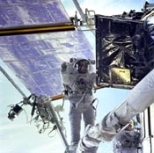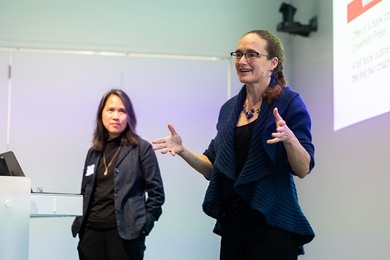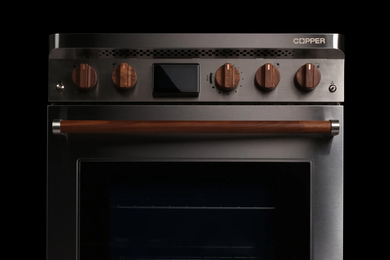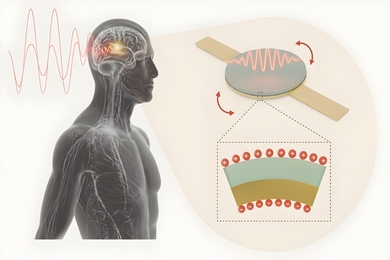MIT scientists who use the Hubble Space Telescope to conduct astronomical observations were thrilled to see Hubble restored to service through the successful efforts of the crew of space shuttle Discovery, including mission specialist John M. Grunsfeld (SB 1980 in physics).
When the third of six gyroscopes on Hubble failed in February 1999, NASA decided to launch a repair mission on an expedited schedule to minimize the potential impact to Hubble's scientific observations. Its fourth gyroscope failed on November 13, resulting in a suspension of scientific observations until the repair mission could be launched.
Dr. Grunsfeld played a key role in the mission, participating in two of the three space walks with fellow astronaut Steven L. Smith. During the first extravehicular activity, they replaced Hubble's six gyroscopes and assured that the telescope would be able to resume scientific observations again. In addition, the crew installed voltage regulator kits on Hubble's batteries, opened valves to vent an instrument cooling system, installed an advanced computer system, replaced a fine guidance sensor, installed an optical control electronics package, replaced an S-band radio transmitter and installed a new solid-state data recorder.
"I realized that I'd been training for this mission nearly all my life. I started studying astronomy and physics at MIT, learning how to build hardware and to work on telescopes," Dr. Grunsfeld said. "I came to MIT planning to pursue a career as a theoretical physicist. I was encouraged to do my thesis in experimental physics and I developed an X-ray astronomy instrument for a high-altitude balloon mission. I also got exposed to spacecraft operations as a controller for MIT's X-ray burst experiment on the SAS-3 satellite."������
"I think MIT is a very special place and the MIT motto 'Mens et Manus' captures the essence of the effort that went into training for and conducting this mission," he continued. "We set out to do something that was very difficult, we trained hard for it and we did it very well. Personally, I felt that the mission to repair Hubble was something important enough to risk my life for."
Dr. Grunsfeld was selected as a NASA astronaut in 1992 and has flown two previous missions, one that conducted the Astro 2 astronomy mission in March 1995 and another that docked with the Mir space station in January 1997. With the completion of the most recent STS-103, he has logged a total of 834 hours in space, including more than 16 hours in extravehicular activity.
HUBBLE RESEARCH AT MIT
Several MIT astronomers use the Hubble Space Telescope in their research. Assistant Professor of Physics Deepto Chakrabarty recently conducted simultaneous observations of an X-ray binary object using both the Hubble Space Telescope and the Rossi X-Ray Timing Explorer (RXTE), named after the late MIT Professor of Physics Bruno Rossi. An X-ray binary object consists of a neutron star that accretes gas from a normal stellar companion, creating an accretion disk around the neutron star.
"It's interesting to note that my current scientific involvement with HST arose out of a long-ago interaction with John Grunsfeld," Professor Chakrabarty said. "I first met John in 1990 when I was a graduate student in physics at Caltech and he was a senior research fellow. He got me interested in a particular cosmic X-ray source called 4U1626-67. John and I discussed various ideas for studying this unusual object, but he left Caltech in 1992 to join the astronaut corps before we could follow through.
"When I returned to MIT in 1996, I was still thinking about this object. In 1998, I observed 4U1626-67 simultaneously using Hubble to measure the ultraviolet pulses and RXTE to measure the X-ray pulses. By measuring the time delay between the X-ray and ultraviolet pulses, and by comparing the smearing of the 'output' ultraviolet pulse compared to the 'input' X-ray pulse, we can learn about the geometry and structure of the disk. We are echo-mapping the accretion disk using the pulsar emission. This is different from what John and I had planned years ago, but I never would have pursued it without his initial encouragement."
Also at MIT, Paul Schechter, the William A.M. Burden Professor of Astrophysics, and Visiting Scientist Lutz Wisotzki from the University of Hamburg are using Hubble to find new gravitational lenses. Gravity changes the index of refraction and results in multiple images when a massive object like a galaxy happens to lie close to the line of sight between the observer and a quasar. Hubble is used to observe bright distant quasars which may appear to be doubled or quadrupled by the presence of a gravitational lens.
A series of 80 "snapshot" observations were conducted with Hubble between July and November 1999, when Hubble's scientific observations were suspended due to the gyroscope failure. One gravitational lens was discovered in September based on these observations.
When Hubble resumed science operations on January 10, Professor Schechter's observation program was scheduled to be among the first observations conducted with the repaired telescope. A total of 300 observations were originally planned as part of the current Hubble observation cycle and an additional 300 observations were recently approved as part of the next Hubble observation cycle beginning in July 2000.
"NASA's decision last February to launch a dedicated space shuttle mission to repair Hubble's gyroscopes is an indication of the importance of the Hubble Space Telescope to the space science community," Professor Schechter said. "We are elated that Hubble is back in service and we are very pleased to be getting data again."
Professor James Elliot of earth, atmospheric and planetary sciences (EAPS) used one of Hubble's Fine Guidance Sensors (FGS) as a high-speed photometer to measure the atmospheric pressure of Neptune's moon Triton as it passed in front of a star. Using the FGS's four photomultipliers, which are highly accurate and stable light detectors, it is possible to record the intensity of the starlight as it dims due to refraction by the planet's atmosphere.
Professor Elliot found that Triton's atmospheric pressure had increased when compared to Voyager spacecraft data that was obtained in its 1989 encounter with the planet Neptune. This pressure increase was used to show that the temperature of Triton's surface had increased by about 5 percent over the eight-year period.
"I'm thrilled to see Hubble restored to service for astronomical observations, since I'm planning to use Hubble to observe an occultation of the planet Pluto by a star in order to study global changes in Pluto's atmosphere," Professor Elliot said. "This work is based on our successful analysis of the atmosphere of Triton, the largest moon of Neptune, based on observations of a Triton occultation using the Hubble Space Telescope in November 1997."
SATURN HYDROXYL CLOUD
Dr. John Richardson, a principal research scientist in the Center for Space Research (CSR), is conducting research to construct a two-dimensional picture of Saturn's hydroxyl cloud. Hubble first detected a cloud of neutral hydroxyl near Saturn in 1992 and has been used in several observations to study different regions of this cloud under various viewing angles.
Data from the Voyager 1 and 2 spacecraft, which included an MIT plasma science experiment, have been used in conjunction with the Hubble data to show that the hydroxyl cloud is actually a narrow disk with its peak density near the orbit of Saturn's moon Enceladus. Dr. Richardson's current theory is that the hydroxyl cloud may have been formed by collisions between Saturn's E-ring and the moon Enceladus.
"Hubble contributes a great deal to the study of the solar system," he said. "In addition to the hydroxyl observations, it has proved invaluable in studies of aurora on Jupiter and Saturn, the volcanoes on Io, and the impact of comet Shoemaker-Levy on Jupiter. Hubble observations have complemented the Galileo mission to Jupiter and will, I hope, play the same role when Cassini goes into orbit about Saturn in 2003."
Professor Claude R. Canizares, director of the CSR and deputy director of the Chandra X-Ray Observatory Center, looks forward to joint observations using HST and the Chandra X-Ray Observatory.
"One of the prime motives of NASA's Great Observatory program was to use Hubble and Chandra together to get a more complete picture of the universe than either one could do alone," he said. "We've set aside time specifically to allow scientists to use both telescopes simultaneously. So keeping Hubble in tip-top shape is of great importance to those of us working with Chandra."
In May 1996, Professor Richard Binzel of EAPS used Hubble to discover a giant impact crater on the asteroid 4 Vesta.
"We are engaged in an ongoing effort to understand the history of this very interesting small planet," he said. "Vesta is unique as the oldest planet whose surface contains a record of volcanic flows. Based on the fascinating world that we're seeing with Hubble, we are proposing to launch a spacecraft mission to orbit Vesta by the end of this decade."
Dr. Joel H. Kastner, a former research scientist at the Center for Space Research, and his colleagues used Hubble's Near Infrared Camera and Multi-Object Spectrometer in 1997 to observe the Egg Nebula, an expanding cloud of gas and dust ejected from a dying star that had depleted its fuel (MIT Tech Talk, May 21, 1997).
And in 1994, MIT scientists under the direction of Heidi B. Hammel, a former EAPS principal research scientist, participated in coordinating HST's observations of the comet Shoemaker-Levy into Jupiter's atmosphere. They found an unexpected result when Hubble observations indicated that the plumes of material that erupted from Jupiter's atmosphere after each impact rose to the same height, independent of the energy of the impact.
A version of this article appeared in MIT Tech Talk on January 12, 2000.







